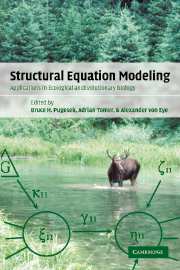Book contents
- Frontmatter
- Contents
- List of contributors
- Preface
- Section 1 Theory
- 1 Structural equation modeling: an introduction
- 2 Concepts of structural equation modeling in biological research
- 3 Modeling a complex conceptual theory of population change in the Shiras moose: history and recasting as a structural equation model
- 4 A short history of structural equation models
- 5 Guidelines for the implementation and publication of structural equation models
- Section 2 Applications
- Section 3 Computing
- Index
3 - Modeling a complex conceptual theory of population change in the Shiras moose: history and recasting as a structural equation model
Published online by Cambridge University Press: 14 October 2009
- Frontmatter
- Contents
- List of contributors
- Preface
- Section 1 Theory
- 1 Structural equation modeling: an introduction
- 2 Concepts of structural equation modeling in biological research
- 3 Modeling a complex conceptual theory of population change in the Shiras moose: history and recasting as a structural equation model
- 4 A short history of structural equation models
- 5 Guidelines for the implementation and publication of structural equation models
- Section 2 Applications
- Section 3 Computing
- Index
Summary
Abstract
This chapter presents an example of how structural equation modeling (SEM) could be used to test a classic theoretical model of population dynamics of the Shiras moose (Alces alces). A longitudinal model is developed in which population density is measured in two waves. The change in population density between the two periods of measure is modeled in relation to a complex set of interrelationships among environmental and population level variables. Included in the model are examples of composite variables and nonzero fixed parameters. Analysis of a simulated data set demonstrates the procedures of a typical SEM study that begins first with a measurement model and proceeds with a series of exploratory and confirmatory analyses. The use and pitfalls of fit statistics, t-values, modification indices, and Q–Q plots as diagnostic tools are demonstrated. Two types of estimate, covariance estimates and standardized estimates, are contrasted. Examples of the calculation of total effects from direct and indirect effects are presented. Results demonstrate a significant potential for using SEM to develop expert systems and ecological models.
- Type
- Chapter
- Information
- Structural Equation ModelingApplications in Ecological and Evolutionary Biology, pp. 60 - 84Publisher: Cambridge University PressPrint publication year: 2003
- 41
- Cited by



